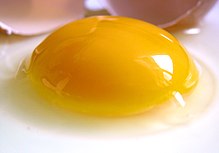Yolk
This article needs additional citations for verification. (May 2007) |
This article needs attention from an expert on the subject. Please add a reason or a talk parameter to this template to explain the issue with the article. (February 2009) |

An egg yolk is a part[1] of an egg which serves as the food source for the developing embryo. The egg yolk is suspended in the egg white (known more formally as albumen or ovalbumin) by one or two spiral bands of tissue called the chalazae. Prior to fertilization, the yolk together with the germinal disc is a single cell; one of the few single cells that can be seen by the naked eye.
As a food, yolks are a major source of vitamins and minerals. They contain all of the egg's fat and cholesterol, and almost half of the protein.
If left intact while cooking fried eggs, the yellow yolk surrounded by a flat blob of egg white creates the distinctive sunny-side up form of the food. Mixing the two components together before frying results in the pale yellow form found in omelettes and scrambled eggs.
Uses

- It is sometimes separated from the egg white and used in cooking (for mayonnaise, custard, hollandaise sauce, crème brûlée, avgolemono, and ovos-moles).
- It is used in painting as a component of traditional egg-tempera.
- It is used in the production of egg-yolk agar plate medium, useful in testing for the presence of Clostridium perfringens.
- Egg yolk also contains an antibody called Immunoglobulin yolk (IgY). The antibody transfers from the laying hen to the egg yolk by passive immunity to protect both embryo and hatchling from microorganism invasion.
- Egg yolk can be used to make liqueurs such as Advocaat.
Composition of chicken egg yolk
The yolk makes up about 33% of the liquid weight of the egg; it contains approximately 60 calories, three times the caloric content of the egg white.
One large egg (50 grams in weight, 17 gram yolk) contains approximately: 2.7g Protein, 210 mg Cholesterol, 0.61g Carbohydrates, 4.51g Total Fat. (USDA National Nutrient Database)
All of the fat soluble vitamins, (A, D, E and K) are found in the egg yolk. Egg yolks are one of the few foods naturally containing vitamin D.
The composition (by weight) of the most prevalent fatty acids in egg yolk is typically as follows:[2]
- Unsaturated fatty acids:
- Oleic acid 47 %
- Linoleic acid 16 %
- Palmitoleic acid 5 %
- Linolenic acid 2 %
- Saturated fatty acids:
- Palmitic acid 23 %
- Stearic acid 4 %
- Myristic acid 1 %
Egg yolk is a source of lecithin, an emulsifier and surfactant.
The yellow color is caused by lutein and zeaxanthin, which are yellow or orange carotenoids known as xanthophylls
Double-yolk eggs

Double-yolk eggs occur when ovulation occurs too rapidly, or when one yolk becomes joined with another yolk. These eggs may be the result of a young hen's productive cycle not yet being synchronized.[3]
Yolkless eggs
Eggs without yolk are called "dwarf" or "wind" eggs.[4] Such an egg is most often a pullet's first effort, produced before her laying mechanism is fully ready. In a mature hen, a wind egg is unlikely, but can occur if a bit of reproductive tissue breaks away, stimulating the egg producing glands to treat it like a yolk and wrap it in albumen, membranes and a shell as it travels through the egg tube. This has occurred if, instead of a yolk, the egg contains a small particle of grayish tissue. An archaic term for a no yolk egg is a "cock" egg.[5] Since they contained no yolk and therefore can't hatch, it was traditionally believed that these eggs were laid by roosters.[citation needed] This type of egg occurs in many varieties of fowl. They have been found in chickens, both standard and bantams, guineas and Coturnix Quail.
These are also eggs that turn rotten (green inside) after the hen has laid the eggs and all eggs have hatched.
References
- ^ Link to page showing image of the structure of a complete chicken egg
- ^ National Research Council, 1976, Fat Content and Composition of Animal Products, Printing and Publishing Office, National Academy of Science, Washington, D.C., ISBN 0-309-02440-4; p. 203, online edition
- ^ "Odd Eggs, Double Yolks, No Yolks, etc". poultryhelp.com. 2005-03-04. Retrieved 2008-10-25.
- ^ "Dwarf Eggs and the Timing of Ovulation in the Domestic Fowl". Nature Publishing Group. 1996-06-25. Retrieved 2008-10-25.
- ^ "FAQ about Eggs". homesteadingtimes.com. 2007-02-06. Retrieved 2008-10-25.
External links
- Anatomy of an Egg from the Exploratorium
- Eggs from the Agricultural Marketing Service of the U.S. Department of Agriculture
- Making egg tempera from The Society of Tempera Painters
